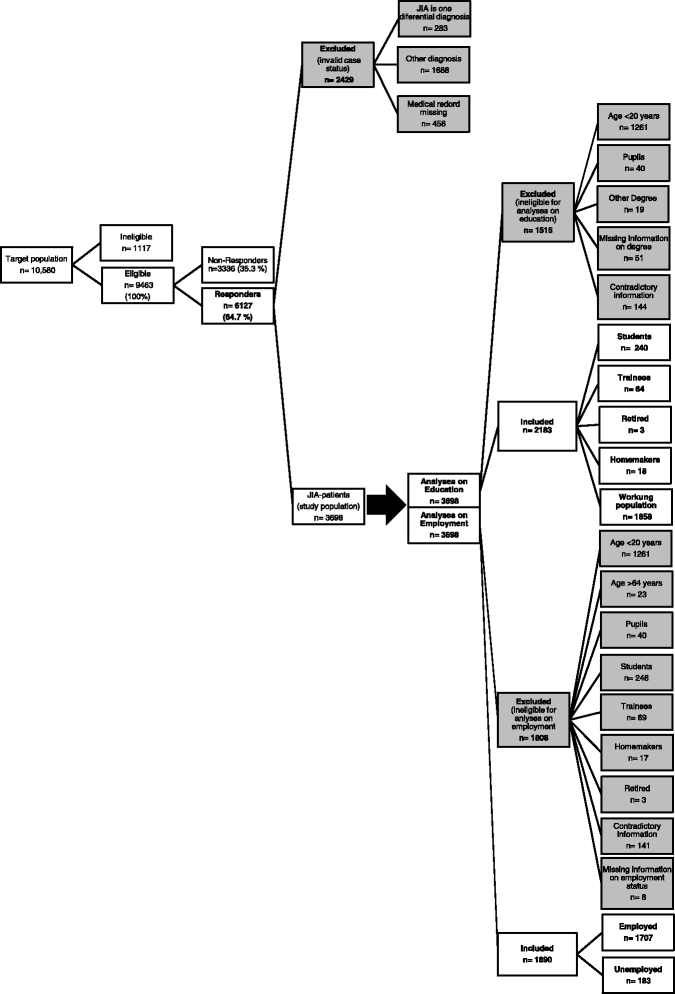Education and employment in patients with juvenile idiopathic arthritis - a standardized comparison to the German general population
- PMID: 28532479
- PMCID: PMC5440947
- DOI: 10.1186/s12969-017-0172-2
Education and employment in patients with juvenile idiopathic arthritis - a standardized comparison to the German general population
Abstract
Background: Although several studies show that JIA-patients have significantly lower employment rates than the general population, the research on educational and occupational attainments in patients with juvenile idiopathic arthritis (JIA) remain conflicting most likely due to small sample sizes. Therefore, aim of this study is to compare the educational achievements and employment status of 3698 JIA-patients with the German general population (GGP).
Methods: "SEPIA" was a large cross-sectional study on the current status of a historic cohort of JIA-patients treated in a single center between 1952 and 2010. For the analyses of education and employment a sub-cohort was extracted, including only adult cases with a confirmed diagnosis of JIA (N = 2696). Participants were asked to fill out a standardized written questionnaire on education and employment. Outcome measures (education/unemployment) were directly standardized to the GGP using data obtained from the National Educational Panel Study 2013 (N = 11,728) and the German Unemployment Statistics 2012 of the Federal Statistical Office (N = 42,791,000).
Results: After age- and sex-standardization, 3% (95% Confidence Interval 1.9 to 4.1%) more of the JIA-patients (26%) than of the GGP (23%) had only reached primary education. In contrast, parents of JIA-patients had similar levels of education as parents in the GGP. With a standardized difference of 0.2% (95% CI: 0.16 to 0.19%), the unemployment rate in JIA-patients was slightly, but not significantly higher than in the GGP. Stratifying for disease duration and the current treatment status, differences were confirmed for persons diagnosed before 2001, whilst for patients diagnosed after 2000, differences were found only in JIA-patients with ongoing disease. Medium and high educational achievements did not differ statistically significant between JIA patients and the GPP.
Conclusion: Educational achievements in German JIA-patients are significantly lower than in the GGP. Furthermore we were able to identify a slightly higher level of unemployment, especially in those with still under treatment and longer disease duration. Better treatment options as well as further development of social support programs might help to overcome this lifelong secondary effect of JIA.
Keywords: Chronic disease; Direct standardization; Education; German general population; Jia; Juvenile idiopathic arthritis.
Figures
Similar articles
-
Outcome in adults with juvenile idiopathic arthritis: a quality of life study.Arthritis Rheum. 2003 Mar;48(3):767-75. doi: 10.1002/art.10863. Arthritis Rheum. 2003. PMID: 12632431
-
Long-Term Health-Related Quality of Life in German Patients with Juvenile Idiopathic Arthritis in Comparison to German General Population.PLoS One. 2016 Apr 26;11(4):e0153267. doi: 10.1371/journal.pone.0153267. eCollection 2016. PLoS One. 2016. PMID: 27115139 Free PMC article.
-
The relationships between adult juvenile idiopathic arthritis and employment.Arthritis Rheum. 2012 Sep;64(9):3016-24. doi: 10.1002/art.34499. Arthritis Rheum. 2012. PMID: 22653553
-
Socioeconomic impact of Hodgkin lymphoma in adult patients: a systematic literature review.Leuk Lymphoma. 2019 Dec;60(13):3116-3131. doi: 10.1080/10428194.2019.1613538. Epub 2019 Jun 6. Leuk Lymphoma. 2019. PMID: 31167589
-
Musculoskeletal diseases in adolescence.J R Coll Physicians Lond. 2000 Mar-Apr;34(2):146-9. J R Coll Physicians Lond. 2000. PMID: 10816869 Free PMC article. Review. No abstract available.
Cited by
-
A quantitative comparison between the essential medicines for rheumatic diseases in children and young people in Africa and the WHO model list.Pediatr Rheumatol Online J. 2024 Jul 4;22(1):63. doi: 10.1186/s12969-024-00997-x. Pediatr Rheumatol Online J. 2024. PMID: 38965620 Free PMC article.
-
Costs of Hospital-Associated Care for Patients With Juvenile Idiopathic Arthritis in the Dutch Health Care System.Arthritis Care Res (Hoboken). 2022 Oct;74(10):1585-1592. doi: 10.1002/acr.24621. Epub 2022 Jul 7. Arthritis Care Res (Hoboken). 2022. PMID: 33938161 Free PMC article.
-
[Adolescent rheumatism : The same but different].Z Rheumatol. 2018 Oct;77(8):694-702. doi: 10.1007/s00393-018-0530-6. Z Rheumatol. 2018. PMID: 30191391 Review. German.
-
Patient's experiences with the care for juvenile idiopathic arthritis across Europe.Pediatr Rheumatol Online J. 2018 Feb 8;16(1):10. doi: 10.1186/s12969-018-0226-0. Pediatr Rheumatol Online J. 2018. PMID: 29422094 Free PMC article.
-
Employment and work ability in individuals living with rare diseases: a systematic literature review.Orphanet J Rare Dis. 2025 Apr 23;20(1):193. doi: 10.1186/s13023-025-03691-7. Orphanet J Rare Dis. 2025. PMID: 40270029 Free PMC article.
References
-
- Eisenstein EM, Berkun Y. Diagnosis and classification of juvenile idiopathic arthritis. J Autoimmun. 2014;(48-49):31–3. - PubMed
Publication types
MeSH terms
LinkOut - more resources
Full Text Sources
Other Literature Sources
Medical


